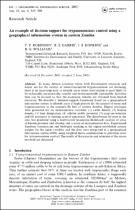 ResearchSpace
ResearchSpace
Example of decision support for trypanosomiasis control using a geographical information system in eastern Zambia.
JavaScript is disabled for your browser. Some features of this site may not work without it.
- ResearchSpace
- →
- Research Publications/Outputs
- →
- Journal Articles
- →
- View Item
| dc.contributor.author |
Robinson, TP

|
|
| dc.contributor.author |
Harris, RS

|
|
| dc.contributor.author |
Hopkins, JS

|
|
| dc.contributor.author |
Williams, BG

|
|
| dc.date.accessioned | 2007-06-12T07:38:40Z | |
| dc.date.available | 2007-06-12T07:38:40Z | |
| dc.date.issued | 2002-06 | |
| dc.identifier.citation | Robinson, TP, et al. 2002. Example of decision support for trypanosomiasis control using a geographical information system in eastern Zambia. International Journal of Geographical Information Science, vol. 16(4), pp 345-360 | en |
| dc.identifier.issn | 1365-8816 | |
| dc.identifier.uri | http://hdl.handle.net/10204/555 | |
| dc.description | Copyright: 2002 Taylor & Francis Ltd | en |
| dc.description.abstract | In many African countries where both Government resources and donor aid for the control of tsetse-transmitted trypanosomiasis are declining, there is an increasing need to identify areas where intervention is most likely to be technically, economically, socially and environmentally sustainable. Activities then can be focused so that the maximum benefits are obtained from limited resources. The authors describe a decision-support framework based on a geographical information system to identify areas of high priority for the control of tsetse and trypanosomiasis in the common fly belt of eastern Zambia. Digital coverage’s were generated for six environmental variables: (1) cattle density, (2) human density, (3) land designation, (4) relative arable potential, (5) crop-use intensity and (6) proximity to existing control operations. The distribution of tsetse in the area was predicted using a multivariate (maximum likelihood) analysis of areas of known presence and absence and a series of environmental data. Experienced Zambian veterinarians and biologists working in the region established criteria weights for the input variables and the data were integrated in a geographical information system (GIS), using weighted linear combinations to prioritize areas for trypanosomiasis control. The results of this exercise and estimates of the errors involved are discussed. | en |
| dc.language.iso | en | en |
| dc.publisher | Taylor & Francis Ltd | en |
| dc.subject | Trypanosomiasis control | en |
| dc.subject | Tsetse transmitted trypanosomiasis | en |
| dc.subject | Decision support framework | en |
| dc.subject | Geographical information system | en |
| dc.subject | Tsetse control | en |
| dc.subject | Multivariate analysis | en |
| dc.subject | Environmental variables digital coverage | en |
| dc.subject | Zambia | en |
| dc.subject | Information systems | en |
| dc.subject | Physical geography | en |
| dc.title | Example of decision support for trypanosomiasis control using a geographical information system in eastern Zambia. | en |
| dc.type | Article | en |
| dc.identifier.apacitation | Robinson, T., Harris, R., Hopkins, J., & Williams, B. (2002). Example of decision support for trypanosomiasis control using a geographical information system in eastern Zambia. http://hdl.handle.net/10204/555 | en_ZA |
| dc.identifier.chicagocitation | Robinson, TP, RS Harris, JS Hopkins, and BG Williams "Example of decision support for trypanosomiasis control using a geographical information system in eastern Zambia." (2002) http://hdl.handle.net/10204/555 | en_ZA |
| dc.identifier.vancouvercitation | Robinson T, Harris R, Hopkins J, Williams B. Example of decision support for trypanosomiasis control using a geographical information system in eastern Zambia. 2002; http://hdl.handle.net/10204/555. | en_ZA |
| dc.identifier.ris | TY - Article AU - Robinson, TP AU - Harris, RS AU - Hopkins, JS AU - Williams, BG AB - In many African countries where both Government resources and donor aid for the control of tsetse-transmitted trypanosomiasis are declining, there is an increasing need to identify areas where intervention is most likely to be technically, economically, socially and environmentally sustainable. Activities then can be focused so that the maximum benefits are obtained from limited resources. The authors describe a decision-support framework based on a geographical information system to identify areas of high priority for the control of tsetse and trypanosomiasis in the common fly belt of eastern Zambia. Digital coverage’s were generated for six environmental variables: (1) cattle density, (2) human density, (3) land designation, (4) relative arable potential, (5) crop-use intensity and (6) proximity to existing control operations. The distribution of tsetse in the area was predicted using a multivariate (maximum likelihood) analysis of areas of known presence and absence and a series of environmental data. Experienced Zambian veterinarians and biologists working in the region established criteria weights for the input variables and the data were integrated in a geographical information system (GIS), using weighted linear combinations to prioritize areas for trypanosomiasis control. The results of this exercise and estimates of the errors involved are discussed. DA - 2002-06 DB - ResearchSpace DP - CSIR KW - Trypanosomiasis control KW - Tsetse transmitted trypanosomiasis KW - Decision support framework KW - Geographical information system KW - Tsetse control KW - Multivariate analysis KW - Environmental variables digital coverage KW - Zambia KW - Information systems KW - Physical geography LK - https://researchspace.csir.co.za PY - 2002 SM - 1365-8816 T1 - Example of decision support for trypanosomiasis control using a geographical information system in eastern Zambia TI - Example of decision support for trypanosomiasis control using a geographical information system in eastern Zambia UR - http://hdl.handle.net/10204/555 ER - | en_ZA |





